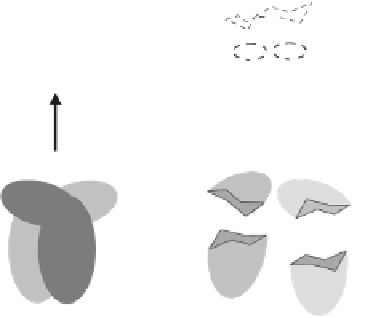Environmental Engineering Reference
In-Depth Information
4. The repair of UV-induced damage of PSII
Repair via de novo protein synthesis
One of the main defense responses of intact photosynthetic cells against UV-B
damage is the repair of PSII via
de novo
synthesis of the D1 and D2 proteins
26
(Figure. 7).
D2
D1
D2
D1
Q
A
Q
B
Fe
UV damage
Phe
Phe
P
680
Tyr-Z
Tyr-D
Mn
Religation
Activation
Protein
degradation
D1
D2
D2
D1
Reassembly
De novo
protein
synthesis
D2
D1
Figure 7.
The scheme of PSII repair
. UV radiation induces the damage and degradation of the D1
and D2 reaction center subunits. The first step of the repair is the
de novo
synthesis of D1 and D2.
This is followed by reassembly of the reaction center, and the religation and activation of the redox
cofactors.
We have recently shown that in the cyanobacterium
Synechocystis
6803 UV-B light
has differential effect on the transcription of the
psbA2
and
psbA3
genes encoding identical
D1 proteins. UV-B irradiation induces a large increase in the accumulation of the
psbA3
mRNA, which gives only a minor fraction (<10 %) of the
psbA
mRNA pool under normal
conditions in wild-type cells
27
. In contrast, only a small increase was observed in the level
of the normally highly expressed
psbA2
mRNA. Similar differential response of the
psbD1
and
psbD2
genes, encoding identical D2 proteins, was also observed in response to UV-B
light
34
. These results show that
psbA3
and
psbD2
act as UV-B stress genes which are
needed for rapid repair of the damaged PSII reaction center subunits.














Search WWH ::

Custom Search